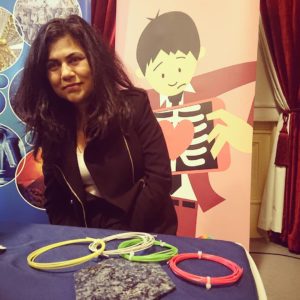
by Catriona Nguyen-RobertsonRSV Communications Officer
This article follows a presentation to the Society on 17 August titled “The Alchemist: Turning Waste into Wealth” by ARC Laureate Professor Veena Sahajwalla, Founding Director of the Centre for Sustainable Materials Research and Technology (SMaRT) at the University of New South Wales.
“We all contribute to the waste problem, but much of it is really a resource that’s waiting for its next life” – Veena Sahajwalla, UNSW.[caption id="attachment_5758" align="alignright" width="200"]

RSV CEO, Mike Flattley introducing Professor Veena Sahajwalla[/caption]Professor Veena Sahajwalla decided to become an engineer after breaking a ceramic sink when trying to crack open a coconut. She discovered that she liked pulling things apart. After growing up in Mumbai, she studied in Canada, the US, and then moved to Australia – where a major waste crisis is now unfolding.To this day she still tears things apart – but is now exploring how she can repurpose the resulting materials. She is pioneering the establishment of micro-factories in Australia to transform waste materials into something of value.

Much of the waste generated in Australia is currently shipped offshore, to be dealt with by other countries, often in less than satisfactory conditions for human health and wellbeing. Veena argues that “if we want a better planet, we should be wanting a better planet for everyone.” Stockpiling waste, whether in Australia or elsewhere, can cause harm to communities and the environment in the form of pollution and fire hazards.Australia, along with many other countries, shipped its recyclable plastic waste to China for many years, which came to an end in 2018. Following China’s ban on receiving recycled waste, Indonesia, Malaysia and Thailand have become dumping grounds, but even they have started to send some of our waste back. Australia does not have strong recycling infrastructure as we have never been impelled to develop it – accordingly, our only solution to the situation has been to send what was originally intended for recycling to landfill. Due to the global shift in waste markets, the pressure is mounting on countries like Australia to start dealing with their own waste onshore. We need innovative methods of processing recyclable waste, and we need them fast.[caption id="attachment_5760" align="alignright" width="300"]

Professor Veena Sahajwalla with a selection of materials and consumables produced with her prototype microfactory at UNSW.[/caption]Instead of shipping waste offshore, we could be harvesting the high value materials in our waste. Each year, 50 million tonnes of e-waste is produced globally. In Australia, fewer than 1.5% of the 4 million computers sold a year are recycled. The total value of the resources embedded in them approximates $70 billion. At the micro-level, computers contain complex arrays of metals, plastic polymers, and glass fibres. Plastics in computer monitors can be used to produce plastic filaments for 3D-printing. The copper in circuit boards is 10 times more concentrated than what is mined in copper ore – looking at a photo of computers piled up in landfill, Veena says “here is a mine sitting above ground yet we let it go to waste.” With the Victorian government now banning the disposal of e-waste in landfill, the pressure is on to turn this dilemma into an opportunity.Computers are not the only objects that contain valuable resource we let go to waste. Batteries contain many rare Earth metals, and packaging contains aluminium that can be recycled into a high grade resource through chemical methods rather than energy-hungry smelting. Veena wants to put all these raw materials all back into the supply chain to “close the loop” of the economy, as close as possible to the point of consumption to mitigate carbon emissions from transportation. The idea is that waste management organisations will harvest materials in waste and either on-sell them to manufacturing companies to make new products, or manufacture products directly on site – and the cycle repeats. In a collaboration between researchers, the government,manufacturers and retailers, materials can be extracted from our waste and reformed into new products. We talk about three R’s: reduce, reuse, and recycle. Veena offers a fourth: reform.Veena's SMaRT centre is currently establishing microfactories in New South Wales. Everyone can be part of the change: the owners of waste materials, designers and manufacturers, and the end users. It would be fantastic to see the initiative, and the opportunities for wealth and jobs creation, gain ground here in Victoria.

Veena is committed to deliver new science, processes and technologies that will drive the redirection of waste from landfills back into production. This will simultaneously reduce production costs and alleviate pressures on the environment from pollution and mining to source new materials. She sees waste as an opportunity rather than a problem – “a positive for our planet and people”.
Our thanks to Veena for generously sharing her centre's work with us for National Science Week! Video footage of her presentation is available from the Society's Facebook page at https://www.facebook.com/royalsocietyvictoria/videos/vl.2282388202000129/653880178452057/ .
Discover how you can join the society
Join The Royal Society of Victoria. From expert panels to unique events, we're your go-to for scientific engagement. Let's create something amazing.












